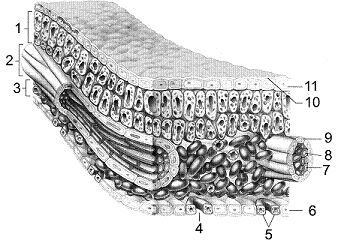In the accompanying figure, the palisade mesophyll is labeled with the number
 :
:
a. 1
b. 2
c. 3
d. 6
e. 9
a
You might also like to view...
Many of the antiviral drugs currently used to treat HIV/AIDS also interfere with an enzyme that helps mitochondria multiply. Treatment can therefore result in a decrease in the number of mitochondria found in certain tissues. Given this information, what might you expect to see in patients treated with antiviral drugs?
A. An increase in oxidative phosphorylation B. An increase in phosphofructokinase activity C. An increase in NADH dehydrogenase activity D. An increase in lactic acid levels Clarify Question What is the key concept addressed by the question? What type of thinking is required? Gather Content What do you already know about which cellular respiration processes occur in mitochondria? How would a reduction in mitochondria affect the ability of the cell to harvest energy? What other information is related to the question? Choose Answer Do you have all necessary information to determine the outcome on respiration from taking antiviral drugs? Reflect on Process Did your problem-solving process lead you to the correct answer? If not, where did the process break down or lead you astray? How can you revise your approach to produce a more desirable result?
Bacteria like E. coli have an average generation time of 24 hours.
Answer the following statement true (T) or false (F)
A digestive cavity in which food enters an opening at one end and passes through the animal in one direction as it is digested is called the
A. gastrovascular cavity. B. stomach. C. alimentary canal. D. epithelial cavity. E. intestine.
All of the following chemicals are vesicant agents, EXCEPT:
A) chlorine. B) lewisite. C) phosgene oxime. D) sulfur mustard.